Monthly Archives: July 2023

 The Hippopotamus is a large, lumbering animal found mostly in Africa, or in zoos in other places. These animals are rather hot blooded and since Africa is often hot too, the like to spend much of their day almost totally immersed in water in an effort to stay cool. The hippopotamus has a bulky body with stumpy legs, an enormous head with a mouth to match, a short tail, and four toes on each foot. Each of the toes has a nail-like hoof. Male hippos are usually about 11.5 feet long, stand 5 feet tall, and weigh 3.5 tons…yes that’s tons…strange considering their relatively short stature. The males are the larger gender in terms of physical size, weighing about 30 percent more than females. The nearly hairless skin is 2 inches thick on the flanks, but thinner elsewhere. Hippos are grayish brown in color, with pinkish underparts. Their huge mouth is half a meter wide and can gape 150° to show the teeth. When the mouth is open, the head almost completely disappears. The lower teeth are very sharp and can be more than 12 inches long.
The Hippopotamus is a large, lumbering animal found mostly in Africa, or in zoos in other places. These animals are rather hot blooded and since Africa is often hot too, the like to spend much of their day almost totally immersed in water in an effort to stay cool. The hippopotamus has a bulky body with stumpy legs, an enormous head with a mouth to match, a short tail, and four toes on each foot. Each of the toes has a nail-like hoof. Male hippos are usually about 11.5 feet long, stand 5 feet tall, and weigh 3.5 tons…yes that’s tons…strange considering their relatively short stature. The males are the larger gender in terms of physical size, weighing about 30 percent more than females. The nearly hairless skin is 2 inches thick on the flanks, but thinner elsewhere. Hippos are grayish brown in color, with pinkish underparts. Their huge mouth is half a meter wide and can gape 150° to show the teeth. When the mouth is open, the head almost completely disappears. The lower teeth are very sharp and can be more than 12 inches long.
Hippopotamus is Greek for “river horse” mainly because of their love of water. So much do they love the water, that Hippos spend up to 16 hours a day submerged in rivers and lakes to keep their massive bodies cool under the hot African sun. As clumsy as they might seem on land, hippos are graceful in water, good swimmers, and can hold their breath underwater for up to five minutes. Often, in the shallow lakes, hippos are large enough to simply walk or stand on the lake floor or lie in the shallows. Because their eyes and nostrils are located high on their heads, they have the ability to see and breathe while mostly submerged. While they spend a lot of time in the water, hippos also like to enjoy the sun on the shoreline and strangely, their bodies secrete an oily red substance, which is where the myth that they sweat blood came from. The liquid is actually a skin moistener and sunblock that may also provide protection against germs. What most people wouldn’t give to have built in moisturizer and sunblock…well, maybe not a heavy sunblock. Hippos come out of the water at sunset and begin their nightly feeding cycle. Often traveling up to six miles, they consume up to 80 pounds of grass. Now, that’s a lot of carbs, but given their size, that is not that much food. Hippos seem like a slow animal, but if they are threatened on land hippos may run for the water, and they can match a human’s speed…for short distances.
In the past, hippos have been used to pull a cart, much like a horse. I suppose it was a common site in Africa, 
 but for most of us today, it would be a strange sight indeed. There was a hippo in the Barnes Circus, names Lotus. Lotus was an obedient cart hippo, but I’m not so sure she was very happy about that cart that was hooked on behind her. It makes sense that she would be unhappy, she was in captivity, and that she couldn’t have been happy with her life. I wonder what would happen if Lotus had been spooked near a pond. My guess is that there would have been one wet driver.
but for most of us today, it would be a strange sight indeed. There was a hippo in the Barnes Circus, names Lotus. Lotus was an obedient cart hippo, but I’m not so sure she was very happy about that cart that was hooked on behind her. It makes sense that she would be unhappy, she was in captivity, and that she couldn’t have been happy with her life. I wonder what would happen if Lotus had been spooked near a pond. My guess is that there would have been one wet driver.

 My grandnephew, Dylan Herr is one busy guy. Dylan is the owner/manager of Red Wing Shoes in Casper, Wyoming, but now he is also managing all of his family’s Red Wing stores. Because of his new position, Dylan has been traveling to and from Colorado quite often, checking in on the stores and training new hires. Right now, Dylan is in Red Wing Minnesota, with some other managers, looking at all the original Red Wing stuff there. Dylan is really enjoying this trip. In addition to all of his new duties, Dylan is also still working at his store in Casper of course. I know that Dylan’s family really appreciates all his hard work. They are a close family, and family helps family. And Dylan is the man for the job.
My grandnephew, Dylan Herr is one busy guy. Dylan is the owner/manager of Red Wing Shoes in Casper, Wyoming, but now he is also managing all of his family’s Red Wing stores. Because of his new position, Dylan has been traveling to and from Colorado quite often, checking in on the stores and training new hires. Right now, Dylan is in Red Wing Minnesota, with some other managers, looking at all the original Red Wing stuff there. Dylan is really enjoying this trip. In addition to all of his new duties, Dylan is also still working at his store in Casper of course. I know that Dylan’s family really appreciates all his hard work. They are a close family, and family helps family. And Dylan is the man for the job.
The hardest part about all the travel that Dylan is doing right now is being away from his family. Dylan is, first and foremost, a family man. His wife, Katy and son, Max are 
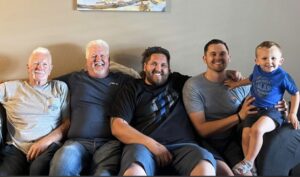 his top priority. All that travel makes spending quality time with family hard, so sometimes Katy and Max “tag along” with Dylan when he travels. That is really nice, and in addition, Dylan makes sure that on his days off, he makes sure to spend his time with Max!! A boy needs time with his daddy, and Dylan is a great daddy.
his top priority. All that travel makes spending quality time with family hard, so sometimes Katy and Max “tag along” with Dylan when he travels. That is really nice, and in addition, Dylan makes sure that on his days off, he makes sure to spend his time with Max!! A boy needs time with his daddy, and Dylan is a great daddy.
Dylan also makes sure to take care of things around the house when he is home. That means doing yard work. Dylan loves his yard. In fact, according to Katy, he is “obsessed” with having a flawless lawn, and never really thinks it’s quite perfect 
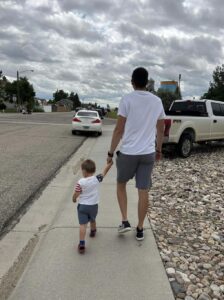 enough. Now if all this isn’t enough, Dylan also spends time going to the gym and playing on a softball team (when he is in town). He has also played in a lot of golf tournaments this summer as well, which is definitely his passion…after his stores, Katy, and Max, of course. Dylan is very dedicated to community. This year, he joined the board of the YMCA and is also part of the Casper Rotary, which he absolutely loves. For Katy, Dylan’s schedule is a extremely overwhelming. She told me that some days, she can’t even keep track of where he’s on a day-to-day basis. Of course, Dylan talks to her every day, but I can certainly see how such a hectic schedule would be hard to keep up with. Today is Dylan’s birthday. Happy birthday Dylan!! Have a great day…wherever you are!! We love you!!
enough. Now if all this isn’t enough, Dylan also spends time going to the gym and playing on a softball team (when he is in town). He has also played in a lot of golf tournaments this summer as well, which is definitely his passion…after his stores, Katy, and Max, of course. Dylan is very dedicated to community. This year, he joined the board of the YMCA and is also part of the Casper Rotary, which he absolutely loves. For Katy, Dylan’s schedule is a extremely overwhelming. She told me that some days, she can’t even keep track of where he’s on a day-to-day basis. Of course, Dylan talks to her every day, but I can certainly see how such a hectic schedule would be hard to keep up with. Today is Dylan’s birthday. Happy birthday Dylan!! Have a great day…wherever you are!! We love you!!
 Many people today think of the “V” sign as meaning Peace, but in reality, the “V” sign used today was actually hijacked. The original “V” sign meant Victory, and it was originally presented as such by Winston Spencer-Churchill at a time when Britain is at one of its lowest points in World War II. Churchill is well known as one of the greatest motivators and speech makers of his time. On July 19, 1941, he launched the “V for Victory” campaign across Europe by telling those in Europe under Nazi control to use the letter “V” (for Victory) at every chance they got in speaking and writing. Churchill urged them to write a capital letter “V” to signify “V” for Victory. This was designed to let the Germans know they still had spirit and believed they would overcome Nazi Rule. The morale of the people was so important and this low point in history. When people give up hope, wars are lost…even before the battles are lost.
Many people today think of the “V” sign as meaning Peace, but in reality, the “V” sign used today was actually hijacked. The original “V” sign meant Victory, and it was originally presented as such by Winston Spencer-Churchill at a time when Britain is at one of its lowest points in World War II. Churchill is well known as one of the greatest motivators and speech makers of his time. On July 19, 1941, he launched the “V for Victory” campaign across Europe by telling those in Europe under Nazi control to use the letter “V” (for Victory) at every chance they got in speaking and writing. Churchill urged them to write a capital letter “V” to signify “V” for Victory. This was designed to let the Germans know they still had spirit and believed they would overcome Nazi Rule. The morale of the people was so important and this low point in history. When people give up hope, wars are lost…even before the battles are lost.
In this campaign, Churchill first gave a speech over the radio to tell the people of his plan. Immediately following his speech, the letter “V” began to appear everywhere. It was painted on walls, tapped out in Morse code on shop counters with knuckles or beer glasses or pencil stubs. It quickly became a rallying call across Europe that there was still hope. Many people weren’t aware, but this is also why Churchill’s most famous pictures from World War II always featured him giving the “V” for Victory Sign. He was continuously telling the people not to give up. That all was not lost, and Victory would still be theirs. We all know the “V” sign. Of course, it was made using the index and middle fingers, raised and parted to make a “V” shape while the other fingers are clenched.
These days, it can mean a number of things, and not all are good. When it is displayed with the palm inward 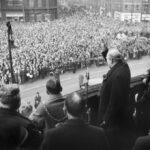 toward the signer, it can be an offensive gesture in some Commonwealth nations (similar to showing the middle finger). That usage dates back to at least 1900. When it is given with the palm outward, it is to be read as a victory sign (“V for Victory”). This usage was first introduced in January 1941 as part of a campaign by the Allies of World War II and made more widely known by Churchill the following July. As most of us know, during the Vietnam War, in the 1960s, the “V sign” with palm outward was widely adopted by the counterculture as a symbol of peace. These days, that is the most commonly used meaning and is commonly called the “peace sign.” Of course, most of us also know that it is used for fun in photographs, especially in East Asia and the United States, where the gesture is also associated with cuteness…the “rabbit ears.” That one is one I have never really figured out. Not what it is, but why people think it’s so funny. Oh well…to each his own.
toward the signer, it can be an offensive gesture in some Commonwealth nations (similar to showing the middle finger). That usage dates back to at least 1900. When it is given with the palm outward, it is to be read as a victory sign (“V for Victory”). This usage was first introduced in January 1941 as part of a campaign by the Allies of World War II and made more widely known by Churchill the following July. As most of us know, during the Vietnam War, in the 1960s, the “V sign” with palm outward was widely adopted by the counterculture as a symbol of peace. These days, that is the most commonly used meaning and is commonly called the “peace sign.” Of course, most of us also know that it is used for fun in photographs, especially in East Asia and the United States, where the gesture is also associated with cuteness…the “rabbit ears.” That one is one I have never really figured out. Not what it is, but why people think it’s so funny. Oh well…to each his own.
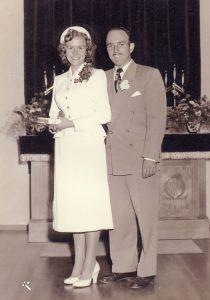
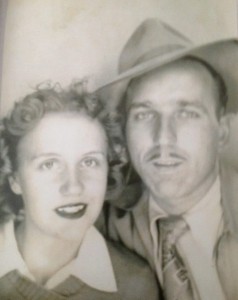 It’s so hard to believe that my parents Allen and Collene Spencer, got married 70 years ago today. When they got married, our mom was a young girl of 17½, with stars in her eyes. Dad was 29, which was not so uncommon back then…after all, her parents were 16 years apart. Their ages, young or older, didn’t matter, because their love was real and forever. And they never seemed like they were 12 years apart in age. They became a family of three ten months later, and over the next nine years they became a family of seven, with five daughters to their credit. While we weren’t rich in money, our family was so rich in love.
It’s so hard to believe that my parents Allen and Collene Spencer, got married 70 years ago today. When they got married, our mom was a young girl of 17½, with stars in her eyes. Dad was 29, which was not so uncommon back then…after all, her parents were 16 years apart. Their ages, young or older, didn’t matter, because their love was real and forever. And they never seemed like they were 12 years apart in age. They became a family of three ten months later, and over the next nine years they became a family of seven, with five daughters to their credit. While we weren’t rich in money, our family was so rich in love.
My sisters, Cheryl Masterson, Caryl Reed, Alena Stevens, Allyn Hadlock, and I went to dinner at Red Lobster last night, and it was so great to think back on the days of our childhood. We talked about the many meals we all had together. It’s funny how so much of life centers around  the dinner table, in whatever form that takes for each family. The closeness of our family while around the dinner table, radiated around us when we went to dinner. We laughed about the times we got to get hamburgers from McDonald’s…ordering 15 hamburgers and seven orders of fries. For some reason, the kids at McDonald’s were less than pleases over those big orders. A fact which we found to be quite funny. We also talked about the “Ice Cream Suppers” that our Uncle Bill Spencer (Dad’s brother) initiated. During a visit to Superior, Wisconsin, Uncle Bill decided that we were going to have ice cream for dinner. We all ordered our favorite treats, and when we were done, to our shock, Uncle Bill asked us what we wanted for dessert. Well, he didn’t have to ask twice, because we quickly ordered a “dessert” treat too. What fun that was. Mom and Dad liked it so much that the tradition came home to grace our dinner table every once in a while, too. It was so yummy!
the dinner table, in whatever form that takes for each family. The closeness of our family while around the dinner table, radiated around us when we went to dinner. We laughed about the times we got to get hamburgers from McDonald’s…ordering 15 hamburgers and seven orders of fries. For some reason, the kids at McDonald’s were less than pleases over those big orders. A fact which we found to be quite funny. We also talked about the “Ice Cream Suppers” that our Uncle Bill Spencer (Dad’s brother) initiated. During a visit to Superior, Wisconsin, Uncle Bill decided that we were going to have ice cream for dinner. We all ordered our favorite treats, and when we were done, to our shock, Uncle Bill asked us what we wanted for dessert. Well, he didn’t have to ask twice, because we quickly ordered a “dessert” treat too. What fun that was. Mom and Dad liked it so much that the tradition came home to grace our dinner table every once in a while, too. It was so yummy!
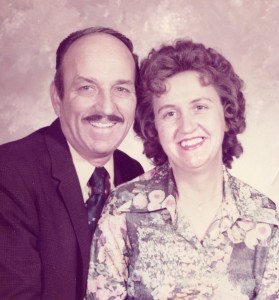

After our wonderful dinner and precious memories of our parents, now both in Heaven, the evening was over. I guess our time around the dinner table mush have bless more people than just us, because as we left, a lady approached my sister, Allyn and told her that they had really enjoyed our laughter. We ere pleased and left the restaurant with even lighter spirits. Today would have been our parents’ 70th anniversary. Happy anniversary Mom and Dad!! We love and miss you both so very much, and we can’t wait until we see you again.

 My daughter, Corrie Petersen and her husband, Kevin Petersen got married on July 17, 1993, meaning that this year is their 30th anniversary. Wow!! How can that be? I know it is, but it still seems like just yesterday that they said, “I do.” They say that the first years of a marriage can be the most difficult, but I never saw that in Corrie and Kevin’s marriage. For them the first years were blissful, and that bliss has only continued to grow as time has gone on.
My daughter, Corrie Petersen and her husband, Kevin Petersen got married on July 17, 1993, meaning that this year is their 30th anniversary. Wow!! How can that be? I know it is, but it still seems like just yesterday that they said, “I do.” They say that the first years of a marriage can be the most difficult, but I never saw that in Corrie and Kevin’s marriage. For them the first years were blissful, and that bliss has only continued to grow as time has gone on.
I can say that the last 6 years have maybe been the most eventful…and in some ways trying, but not in a negative way. These last six years have brought Corrie a new and exciting career in nursing, for which she has worked incredibly hard, and for which Kevin has sacrificed time with her so she could study. While Corrie’s studies and 
 career change have been hard work, they are now reaping the benefits of her success, and they are both very happy. Now they can start to spend more time together again, and they are loving that for sure, with plans to go camping soon.
career change have been hard work, they are now reaping the benefits of her success, and they are both very happy. Now they can start to spend more time together again, and they are loving that for sure, with plans to go camping soon.
The past 30 years have brought many life changes for this beautiful couple. Their family went from being a couple to a family of four, when their sons, Chris and Josh Petersen were born. Now their family has grown with the addition of two daughters-in-law, Karen and Athena Petersen, as well as grandchildren, Cambree, Caysen, and Justin Petersen. In addition, they are expecting two more grandsons in late September and mid-October. So not they are actually a family of eleven. Just look what love did.
The future is so bright for these two kids…I still get to call them kids, because they will always be my kids. It’s  a mother’s right. Even as adults with a growing family of their own and such a promising new career, they are my kids…both of them. I am the kind of person who never things of in-laws as in-laws. They are family and that makes this growing family my kids…all of them. The kids are so excited about the coming new babies, and they have been so blessed by their whole family. and they have all been a blessing to me and my husband, Bob Schulenberg, Corrie’s parents. Today is Corrie and Kevin’s 30th wedding anniversary. They say the 30th anniversary is the “pearl” anniversary. I say that these kids are “pearls” of great value!! Happy 30th anniversary Corrie and Kevin!! We are so proud of you both, and we love you very much.
a mother’s right. Even as adults with a growing family of their own and such a promising new career, they are my kids…both of them. I am the kind of person who never things of in-laws as in-laws. They are family and that makes this growing family my kids…all of them. The kids are so excited about the coming new babies, and they have been so blessed by their whole family. and they have all been a blessing to me and my husband, Bob Schulenberg, Corrie’s parents. Today is Corrie and Kevin’s 30th wedding anniversary. They say the 30th anniversary is the “pearl” anniversary. I say that these kids are “pearls” of great value!! Happy 30th anniversary Corrie and Kevin!! We are so proud of you both, and we love you very much.
 People have been fascinated with Saint Bernard dogs for years. There have been movies made about them, often portraying them as clumsy, drooling pests that “terrorize” homes by making massive messes. Saint Bernards might seem like they are big and clumsy, but for many years, they have been saving lives, and they weren’t clumsy about their work at all. In fact, they were experts at their work.
People have been fascinated with Saint Bernard dogs for years. There have been movies made about them, often portraying them as clumsy, drooling pests that “terrorize” homes by making massive messes. Saint Bernards might seem like they are big and clumsy, but for many years, they have been saving lives, and they weren’t clumsy about their work at all. In fact, they were experts at their work.
In the early 18th century some monks, who were living in the snowy and dangerous Saint Bernard Pass, which is a route through the Alps between Italy and Switzerland, kept these dogs to help them on their rescue missions after bad snowstorms. In fact, the Saint Bernard dogs got their name from the pass where the monks were located. Over a span of nearly 200 years, about 2,000 people, from lost children to Napoleon’s soldiers, were rescued because of the heroic dogs’ uncanny sense of direction and resistance to cold. Of course, there were changes in the dogs through crossbreeding, and finally the dogs became the amazing new breed they are today. While the dogs are amazing as rescue dogs, Saint Bernard dogs are also commonly seen in households today.
The dogs were trained to hunt for people who were lost, and when they found them, the dogs allegedly carried a small cask of liquor around their neck…although, this has not been documented for sure. Then, the dog would lay on top of the victim to keep them warm. Being lost in a snowstorm, often called “white death” could become a death sentence, because hypothermia would soon set in, and the victim would be lost. At a little more than 8,000 feet above sea level, the Great Saint Bernard Pass is a 49-mile route in the Western Alps. The pass is covered with snow for most of the year, and in fact, it is only snow free for a couple of months during the 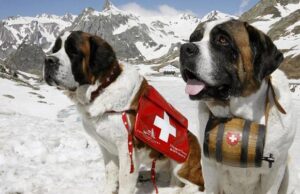 summer. Throughout history, the route has been a treacherous one for many travelers. Of course, that didn’t stop people from trying to make the trek. An Augustine monk named Saint Bernard de Menthon founded a hospice and monastery around the year 1050, which is how Saint Bernard Pass came into being. Sometime between 1660 and 1670, the monks at Great Saint Bernard Hospice acquired their first Saint Bernards. These dogs were descendants of the mastiff style Asiatic dogs brought over by the Romans. The dogs were to be used as watchdogs and companions. The original Saint Bernards were quite a bit smaller in size, had shorter reddish brown and white fur, and a longer tail.
summer. Throughout history, the route has been a treacherous one for many travelers. Of course, that didn’t stop people from trying to make the trek. An Augustine monk named Saint Bernard de Menthon founded a hospice and monastery around the year 1050, which is how Saint Bernard Pass came into being. Sometime between 1660 and 1670, the monks at Great Saint Bernard Hospice acquired their first Saint Bernards. These dogs were descendants of the mastiff style Asiatic dogs brought over by the Romans. The dogs were to be used as watchdogs and companions. The original Saint Bernards were quite a bit smaller in size, had shorter reddish brown and white fur, and a longer tail.
Travel on the Saint Bernard Pass route was so dangerous, and at the turn of the century, servants used as guides were assigned to accompany travelers between the hospice and Bourg-Saint-Pierre, a municipality on the Swiss side. The trek was even treacherous for them, and by 1750, the guides were routinely accompanied by the dogs, whose broad chests helped to clear paths for travelers. While working with the dogs, the guides soon discovered that the dogs had a tremendous sense of smell, as well as their ability to discover people buried deep in the snow. Soon the dogs were sent out in packs of two or three alone to seek lost or injured travelers. Once they found a lost traveler, one dog would stay with the victim, while the other or others would go back to the hospice to bring help.
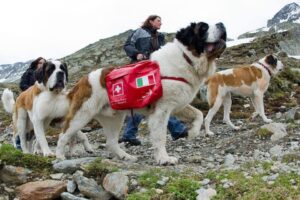 So good were these dogs at their work, that when Napoleon and his 250,000 soldiers crossed through the pass between 1790 and 1810, not one soldier lost his life. The soldiers’ chronicles tell of how many lives were saved by the dogs in what the army had named “the White Death.” So amazing were these dogs, that one, named Barry, that was particularly legendary, who lived in the monastery from 1800-1812, saved the lives of more than 40 people. In 1815, Barry’s body was put on exhibit at the Natural History Museum in Berne, Switzerland, where it remains today. Saint Bernard dogs have proven themselves to be a vital part of mountain rescue operations.
So good were these dogs at their work, that when Napoleon and his 250,000 soldiers crossed through the pass between 1790 and 1810, not one soldier lost his life. The soldiers’ chronicles tell of how many lives were saved by the dogs in what the army had named “the White Death.” So amazing were these dogs, that one, named Barry, that was particularly legendary, who lived in the monastery from 1800-1812, saved the lives of more than 40 people. In 1815, Barry’s body was put on exhibit at the Natural History Museum in Berne, Switzerland, where it remains today. Saint Bernard dogs have proven themselves to be a vital part of mountain rescue operations.

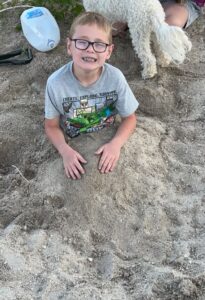 My nephew, Chris Killinger is the office and purchasing manager for Atlas Aero Service, located at the Casper-Natrona County International Airport, which means that he gets to see all to planes that come and go from the airport, some are military, some are private jets (often from celebrities), some cargo planes, and others are commercial liners. A lot of these planes land for fuel, but a large number also land to go through customs, because the process is faster in a small airport, and with the international status of this airport, comes that coveted ease of the customs process. That doesn’t mean that they don’t get a thorough inspection coming through, but rather that the lines are shorter.
My nephew, Chris Killinger is the office and purchasing manager for Atlas Aero Service, located at the Casper-Natrona County International Airport, which means that he gets to see all to planes that come and go from the airport, some are military, some are private jets (often from celebrities), some cargo planes, and others are commercial liners. A lot of these planes land for fuel, but a large number also land to go through customs, because the process is faster in a small airport, and with the international status of this airport, comes that coveted ease of the customs process. That doesn’t mean that they don’t get a thorough inspection coming through, but rather that the lines are shorter.
Chris and my niece, Lacey Stevens, who are engaged to be married in the fall, took his kids, Brooklyn and Jaxon Killinger camping at Pathfinder Reservoir over the 4Th of July with the  Stevens family. Chris and their brother-in-law, Matt Miller taught the kids how to drive the Rangers, and of course, that set off a whole new experience for the kids. And they loved it. They wanted to be on the Rangers the whole time they were there. The whole family was there and they got a kick out of the kids’ new-found love of “driving!!”
Stevens family. Chris and their brother-in-law, Matt Miller taught the kids how to drive the Rangers, and of course, that set off a whole new experience for the kids. And they loved it. They wanted to be on the Rangers the whole time they were there. The whole family was there and they got a kick out of the kids’ new-found love of “driving!!”
Earlier in the summer, they took the kids to Denver for a Memorial Day/birthday trip for Brooklyn. They went to the Denver Zoo and did so many other fun things. Chris is a great dad, and his family is very blessed to have him in their lives. He has also been a great blessing for my sister, Alena Stevens’ whole family too. They all really love Chris, with his kind and his gentle ways. He is a perfect match for Lacey and that makes the whole family very happy.
Chris has been so supportive to Lacey as she embarked on a new endeavor…her own hair salon. He often posts 
 little “ads” to let people know that Lacey is out there and encouraging people to give her a call. He is without doubt, her biggest fan, well, maybe it’s a tie between him and her parents. Starting a new business is never easy, and it’s so nice to have the full support and even free advertising from the love of your life. That’s what Lacey had, and the whole venture has been a great one. Today is Chris’ birthday. Happy birthday Chris!! Have a great day!! We love you!!
little “ads” to let people know that Lacey is out there and encouraging people to give her a call. He is without doubt, her biggest fan, well, maybe it’s a tie between him and her parents. Starting a new business is never easy, and it’s so nice to have the full support and even free advertising from the love of your life. That’s what Lacey had, and the whole venture has been a great one. Today is Chris’ birthday. Happy birthday Chris!! Have a great day!! We love you!!

 Like school children, my nephew, Shannon Moore’s birthday always falls during his vacation from school, or in his case, work. Nevertheless, Shannon’s work is tied to school, because he is the assistant coach for the Wyoming Cowboys football team. He is also their tight ends coach and helps with special teams too. His job allows for time off in the summer, so he is able to have his birthday off each year…a very nice thing for him and his family.
Like school children, my nephew, Shannon Moore’s birthday always falls during his vacation from school, or in his case, work. Nevertheless, Shannon’s work is tied to school, because he is the assistant coach for the Wyoming Cowboys football team. He is also their tight ends coach and helps with special teams too. His job allows for time off in the summer, so he is able to have his birthday off each year…a very nice thing for him and his family.
Shannon is a great dad. Being a teacher, he loves to teach their daughter, Mackenzie new things. This year’s big event is that Mackenzie can now jump off of the diving board at the pool, and then swim to the side. That’s pretty impressive for a 6-year-old girl. Mackenzie trusts her daddy implicitly, and if he thinks she can do it, she is fearless. The two of them have a beautiful daddy-daughter relationship and it is a delight to his wife, my niece, Lindsay Moore. Shannon is a great teacher, and that is what makes him a great coach.
Shannon has a true servant’s heart though and that has been so obvious this year. The family has gone through so many things over the past few years, and Shannon’s servant’s heart and giving nature has been made so clear tp Lindsay in this year of trial. Shannon is ready and willing t help anyone in need, with anything they need. He knows how it feels to go through tough things, and he wants to make the road a little easier for anyone he can. He is genuinely happy to help…to serve, and Lindsay can tell it comes from a loving heart, as can anyone who knows this beautiful couple. Shannon is a giver, as so is Lindsay. They both serve the Lord with 
 gladness, even in adversity. They let nothing get them down, even loss. I have never seen such devotion to God, no matter what a person is facing. They have been able to see God’s blessings in their lives no matter what.
gladness, even in adversity. They let nothing get them down, even loss. I have never seen such devotion to God, no matter what a person is facing. They have been able to see God’s blessings in their lives no matter what.
Shannon has loved Lindsay since the moment they met, and she feels exactly the same way. They are so perfect for each other, and they as such a loving couple. It is so sweet to see them acting like newlyweds even after almost ten years of marriage. As Lindsay says, “Obviously, I love Shannon, we love Shannon, everyone loves Shannon!” She is right, of course, we do all love Shannon. And Lindsay wanted me to make sure that I mentioned that “He’s SUPER HANDSOME!” Today is Shannon’s birthday. Happy birthday Shannon!! Have a great day!! We love you!!
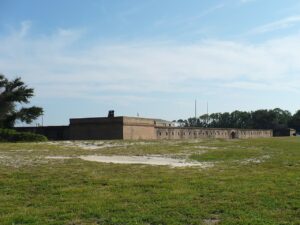 I love old military sites, like forts, and from one to another, they are so many differences. In Casper, Wyoming, where I live, Fort Caspar is a typical Old West fort as you would expect of the days of wagon trains and Indian rampages, but when you look at a fort back east and especially along coastal waters, where it would be necessary to protect our borders, they are much more military looking. Fort Gaines, located the eastern tip of Dauphin Island, off the Gulf coast of Alabama, is a very different looking fort, as my mind pictures forts anyway. Fort Gaines’ well-preserved ramparts, which have guarded the entrance to Mobile Bay for more than 150 years, look very much like they did when they were first built there. The structure is considered one of the nation’s best-preserved Civil War era masonry forts. However, it is also under threat from erosion, as is common of very old structures. The present Fort Gaines was initially designed in 1818 as the identical twin to Fort Morgan, which stands across Mobile Bay, to defend the new territory of Alabama. It was named for General Edmund Pendleton Gaines, a hero of the War of 1812. However, when Congress cancelled funding in 1821, work on the fort was suspended. Years later, when more funding became available 1846, the original design was scrapped, and when construction began in 1857 a new pentagonal-shaped design took its place. The objective of the fortress was to guard the seaward approaches to Mobile Bay and the eastern entrance of the Mississippi Sound.
I love old military sites, like forts, and from one to another, they are so many differences. In Casper, Wyoming, where I live, Fort Caspar is a typical Old West fort as you would expect of the days of wagon trains and Indian rampages, but when you look at a fort back east and especially along coastal waters, where it would be necessary to protect our borders, they are much more military looking. Fort Gaines, located the eastern tip of Dauphin Island, off the Gulf coast of Alabama, is a very different looking fort, as my mind pictures forts anyway. Fort Gaines’ well-preserved ramparts, which have guarded the entrance to Mobile Bay for more than 150 years, look very much like they did when they were first built there. The structure is considered one of the nation’s best-preserved Civil War era masonry forts. However, it is also under threat from erosion, as is common of very old structures. The present Fort Gaines was initially designed in 1818 as the identical twin to Fort Morgan, which stands across Mobile Bay, to defend the new territory of Alabama. It was named for General Edmund Pendleton Gaines, a hero of the War of 1812. However, when Congress cancelled funding in 1821, work on the fort was suspended. Years later, when more funding became available 1846, the original design was scrapped, and when construction began in 1857 a new pentagonal-shaped design took its place. The objective of the fortress was to guard the seaward approaches to Mobile Bay and the eastern entrance of the Mississippi Sound.
Dauphin Island was used for centuries by the Native Americans, who went there to fish, hunt, and gather oysters and other shellfish that grew in abundance in Mobile Bay. To this day, evidence of their presence can 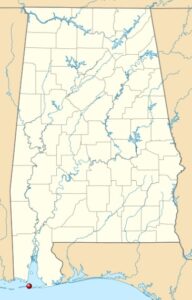 still be seen at Shell Mound Park on the Island’s north shore. The island was also visited by Italian explorer Americus Vespucius, who is said to have visited in 1497. In addition, the Spanish discovered the island, which they named Isle de Labe (Island of the Ridge) from the large sand dunes that extend along its southern shores. The French took possession in 1699 the French and renamed it the Isle de Massacre, because they found so many skeletons scattered on the beach that they thought a massacre had taken place there. The French established a settlement on the island that was raided by pirates in 1711, but survived.
still be seen at Shell Mound Park on the Island’s north shore. The island was also visited by Italian explorer Americus Vespucius, who is said to have visited in 1497. In addition, the Spanish discovered the island, which they named Isle de Labe (Island of the Ridge) from the large sand dunes that extend along its southern shores. The French took possession in 1699 the French and renamed it the Isle de Massacre, because they found so many skeletons scattered on the beach that they thought a massacre had taken place there. The French established a settlement on the island that was raided by pirates in 1711, but survived.
Jean-Baptiste Le Moyne de Bienville, the French Governor, built a fort there that’s he called Fort Torabigbee and changed the name of the island to Dauphin Island after a member of French royalty, “Dauphine” about 1712. From 1763 to 1783, the English held this Island, and in 1783 it went back to Spain. Finally, after years of dispute as to ownership, in 1812, Dauphin Island was taken by the United States during the War of 1812 because it was said the Spanish sympathized with the English. The earliest American fortification built here was in 1812, and that area has belonged to the United States since that time.
Before the fort was fully completed, the Alabama state militia seized it on January 5, 1861, because they were anticipating the state seceding from the Union. That did occur on January 11, 1861. Following the secession, Confederate engineers completed the fort over the next several years. During the Civil War, the fort played an vital role in the Battle of Mobile Bay, and it was within sight of its walls that Union Admiral David G Farragut issued his immortal command, “Damn the torpedoes! Full speed ahead!” After Farragut and his ships forced their way into the bay, Union soldiers laid siege to Fort Gaines, which surrendered on August 8, 1864. After the Union forces took possession of the fort, it was used to plan and stage the final attack on Mobile, Alabama.
Following the Civil War, the fort was repaired by engineers, but the post stood empty for years. Between 1901 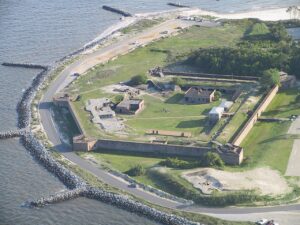 and 1904, two modern gun batteries were built. These housed six guns that complemented the modernizations at nearby Fort Morgan. Other than the basic preservation repairs, Fort Gaines was not further improvements. Fort Gaines, like its sister complex, Fort Morgan and other forts, was no longer needed for harbor defense, as its guns were outmatched by those on foreign battleships. When World War I ended the War Department sold Fort Gaines to the state of Alabama, however it was reactivated briefly during World War II and then returned to the state once again. The state opened Fort Gaines as a state park in 1955. Fort Gaines is currently under the management of the Dauphin Island Park and Beach Board.
and 1904, two modern gun batteries were built. These housed six guns that complemented the modernizations at nearby Fort Morgan. Other than the basic preservation repairs, Fort Gaines was not further improvements. Fort Gaines, like its sister complex, Fort Morgan and other forts, was no longer needed for harbor defense, as its guns were outmatched by those on foreign battleships. When World War I ended the War Department sold Fort Gaines to the state of Alabama, however it was reactivated briefly during World War II and then returned to the state once again. The state opened Fort Gaines as a state park in 1955. Fort Gaines is currently under the management of the Dauphin Island Park and Beach Board.
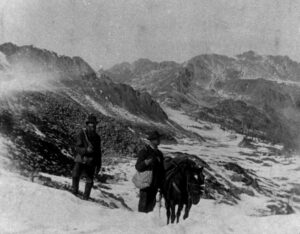 When we think of the Gold Rush years, most of us think of California, but in reality, not every big strike was in California. One of the greatest gold rushes of North America occurred in the Pike’s Peak area. Known as the Pike’s Peak Gold Rush, it was also called the Colorado Gold Rush. The Pike’s Peak Gold Rush a boom in gold prospecting and mining in the Pike’s Peak area of what was then the western Kansas Territory and southwestern Nebraska Territory of the United States. Now it is located in Colorado, of course. The rush began in July 1858 and lasted until just about the time of the creation of the Colorado Territory on February 28, 1861. The rush brought an estimated 100,000 gold seekers, called the Fifty-Niners to the Pike’s Peak area. It was part of one of the greatest gold rushes in North American history.
When we think of the Gold Rush years, most of us think of California, but in reality, not every big strike was in California. One of the greatest gold rushes of North America occurred in the Pike’s Peak area. Known as the Pike’s Peak Gold Rush, it was also called the Colorado Gold Rush. The Pike’s Peak Gold Rush a boom in gold prospecting and mining in the Pike’s Peak area of what was then the western Kansas Territory and southwestern Nebraska Territory of the United States. Now it is located in Colorado, of course. The rush began in July 1858 and lasted until just about the time of the creation of the Colorado Territory on February 28, 1861. The rush brought an estimated 100,000 gold seekers, called the Fifty-Niners to the Pike’s Peak area. It was part of one of the greatest gold rushes in North American history.
The peak year for the gold rush was 1859, and so after that year, the miners were called Fifty-Niners. The miners often used the motto “Pike’s Peak or Bust!” Actually, the location of the Pike’s Peak Gold Rush was centered 85 miles north of Pike’s Peak, but because of the well-known mountain, and its visibility from a long way off, the name of the peak became the name of the rush. The Pike’s Peak Gold Rush, began about a decade after the California Gold Rush, and produced a dramatic, albeit temporary influx of migrants and immigrants into the Pike’s Peak Country of the Southern Rocky Mountains. When the rush ended many of them moved on to other placed in search o the next big rush. The prospectors provided the first major European-American population in the region. The rush brought with it a few mining camps such as Denver City and Boulder City that would actually develop into cities that still exist today. Many smaller camps such as Auraria and Saint Charles City were among those that were later absorbed by larger camps and towns. Still others, faded into ghost towns, but quite a few camps such as Central City, Black Hawk, Georgetown, and Idaho Springs survived.
The discovery of gold in the Pike’s Peak area wasn’t a surprise to everyone. In 1835, French trapper Eustace Carriere lost his party and ended up wandering through the mountains for many weeks. During those weeks he 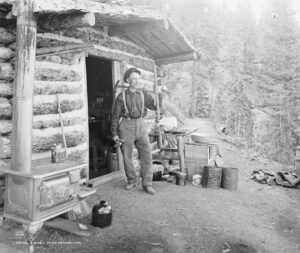 found many gold specimens which he later took back to New Mexico for examination. I suppose it was worth being lost, but while the specimens turned out to be “pure gold” he was unable to locate the area on an expedition he led to go back and look for it. He just couldn’t quite remember the location. Also, in 1849 and 1850, several parties of gold seekers bound for the California Gold Rush panned small amounts of gold from various streams in the South Platte River valley at the foot of the Rocky Mountains. They decided that they weren’t really impressed with the Rocky Mountain gold, so they moved on to California, possibly cheating themselves out of a great find, had the persevered.
found many gold specimens which he later took back to New Mexico for examination. I suppose it was worth being lost, but while the specimens turned out to be “pure gold” he was unable to locate the area on an expedition he led to go back and look for it. He just couldn’t quite remember the location. Also, in 1849 and 1850, several parties of gold seekers bound for the California Gold Rush panned small amounts of gold from various streams in the South Platte River valley at the foot of the Rocky Mountains. They decided that they weren’t really impressed with the Rocky Mountain gold, so they moved on to California, possibly cheating themselves out of a great find, had the persevered.
When the California Gold Rush began to die out, many discouraged gold seekers started to return home. Still, they weren’t really wanting to go home empty-handed, and they has heard the rumors of gold in the Pike’s Peak area. So, they tried their luck again, and their hard work paid off. In the summer of 1857, a party of Spanish-speaking gold seekers from New Mexico worked a placer deposit along the South Platte River about 5 miles above Cherry Creek, now part of metropolitan Denver.
William Greeneberry “Green” Russell was a Georgian man who had worked in the California gold fields in the 1850s. He was married to a Cherokee woman, and through his connections to the tribe, he heard about an 1849 discovery of gold along the South Platte River. Much encouraged, he organized a party to prospect along the South Platte River. He set out with his two brothers and six companions in February 1858. They met up with Cherokee tribe members along the Arkansas River in present-day Oklahoma and continued westward along the Santa Fe Trail. Others joined the party along the way until their number reached 107 people.
When you have spent any time in Colorado, the names of the places where gold was found are very real to you. Places like Cherry Creek, Denver, Confluence Park in Denver, Englewood, and a number of others stand out to you. The group finally found a small amount of 20 troy ounces in the Englewood area. Their excitement grew…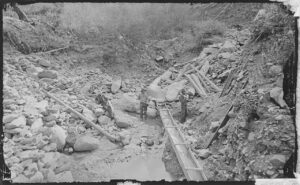 and so the boom began. The first decade of the boom was largely concentrated along the South Platte River at the base of the Rocky Mountains, in the canyon of Clear Creek in the mountains west of Golden City, at Breckenridge and in South Park at Como, Fairplay, and Alma. The towns of Denver City, Golden City, and Boulder City were substantial towns that served the mines in 1860. It was the rapid population growth of the Pike’s Peak Gold Rush that led to the creation of the Colorado Territory in 1861. Unfortunately, the rush, like all gold rushes, faded and while Colorado is still a fairly large population area, it isn’t what it might have been had the gold rush continued.
and so the boom began. The first decade of the boom was largely concentrated along the South Platte River at the base of the Rocky Mountains, in the canyon of Clear Creek in the mountains west of Golden City, at Breckenridge and in South Park at Como, Fairplay, and Alma. The towns of Denver City, Golden City, and Boulder City were substantial towns that served the mines in 1860. It was the rapid population growth of the Pike’s Peak Gold Rush that led to the creation of the Colorado Territory in 1861. Unfortunately, the rush, like all gold rushes, faded and while Colorado is still a fairly large population area, it isn’t what it might have been had the gold rush continued.

